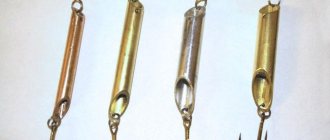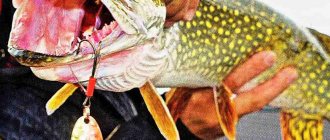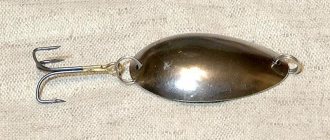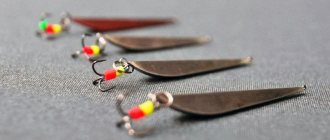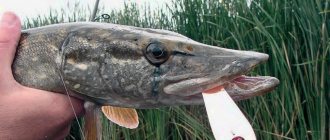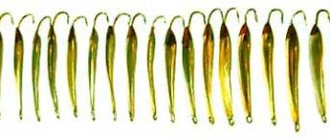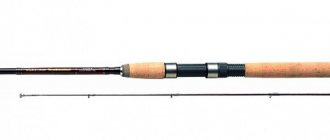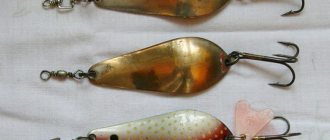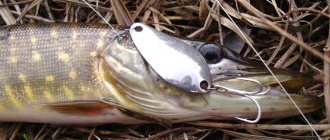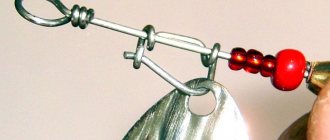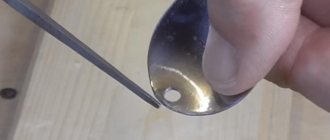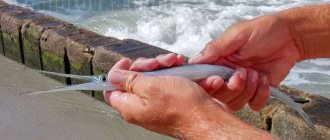Many anglers have the wrong opinion about the spoon. For some reason they think that a spoon should look like a fish, and they try to make or buy a spoon that resembles a fish. However, in fact, predatory fish grab the lure out of instinct. The main property of a spoon that attracts fish is its movement.
You can read about the basics of glittering techniques at this link
In practice, I was convinced that bait for predatory fish does not necessarily have to look like a fish. One winter on the river, one local angler successfully caught pike on a piece of lead with a tee and a red cloth suspended from it. The pike did not react in any way to our silver-plated and brass spoons, which looked like fish. Occasionally a pike would also catch a “devil”, which in no way resembles a fish.
Perch is excellently caught with a jig; it readily grabs a spoon with a bunch of red threads (not black or green). Spinning fishermen know that often a perch grabs not a spoon, but a load that doesn’t look like a fish at all. At the same time, perch rarely takes a stationary spoon or jig. It also happens that predators are caught only with live fish.
Not only do fish tastes change throughout the seasons, they can change throughout the day. I know of many cases when, until a certain hour, perch was caught exclusively with a jig, the rest of the time - only with fry, to which I did not pay any attention in the morning. It should be noted, however, that during the feeding period the predatory fish grabs everything that moves.
A spinner equipped with a hanging tee with red threads brings great success.
Lately, I’ve been increasingly fishing exclusively with spoons with a hanging tee, sometimes with a single hook (if the bite is good, to make it easier to remove the hook from the predator’s mouth).
Selection of catchable spoons
The selection of a catchable spoon is determined by many factors, in particular the nature of the reservoir. Let's say, on a reservoir without a current, one spoon is good, and with a current, another. There are reservoirs where perch is caught with spoons of different colors and brightness, and in others - only with lead spoons. It should be added that perch fishes better with silver-plated spoons than with nickel-plated ones.
It is known: a predator grabs a spoon because, when moving in the water column, it produces vibrations similar to those produced by a moving fish. The predator perceives these vibrations with its lateral line and begins pursuit. In the last seconds, before lunging at the prey, the predator corrects its movements using vision. In this case, the victims are often those individuals who are weakened due to illness or injury, or who have strayed from the flock. In different bodies of water, the main food of one or another predator is various fish. If, say, in a given reservoir the main food for the fish is roach, then the most catchy bait here will be the one that, when moving in the water, produces vibrations most similar to those made by a sick or wounded roach. Of course, there are universal spoons that are equally catchy in many bodies of water. Such spoons successfully imitate the oscillating movements of fish, which, although not the main food of a predator in a given body of water, is quite widespread. These include, for example, roach, perch, ruff, etc.
If it drags along the bottom, then wind the line onto the reel at such a speed that the bait does not touch the bottom, but hits it 2-3 seconds after the reeling stops.
If the bait does not reach the bottom from the very beginning without winding the line onto the reel, you need to let the current unwind the line from the reel until the bait hits the bottom. If the weight of the bait is correctly selected, the impact on the bottom should occur no later than 3-4 m of the line is removed.
Another wiring option is also possible. After lifting the bait from the bottom with several turns of the reel, they continue retrieving without reeling in the line or slowly release it so that the bait comes into contact with the bottom while quickly releasing 2-3 m of line.
In both options, the wiring process lasts until the bait is carried almost straight out. At this moment, they release the line until the bait hits the bottom, and then, having made a few turns with the reel, lift the bait and hold the rod, without reeling in the line, until it is completely out in a straight line.
The bait brought out straight is held for 4-5 seconds without winding or releasing the line, after which it is released a few more meters until the bait touches the bottom, the bait is torn off the bottom and again held without winding for 3-4 seconds, then the line is quickly reeled in and a new cast is made.
Next time, cast further or closer, taking into account that with a far cast the bait will go deeper, and with a close cast it will go shallower. If the first cast was correct, then a distant cast should be made not across the current, but somewhat lower, while a close cast should be made upstream.
A small adjustment to the depth can be made by changing the angle of the rod to the surface of the water.
Bites are most often observed when the bait passes the last third of the way - before taking it out onto the straight line and during the take-out itself, since it is at this moment that it plays the most seductively.
Thus, with a casting distance of 60 m, an area about 20 m wide is well fished. Therefore, after making a dozen casts, it is advisable to move 20 m to the right or left.
Sometimes, especially with an uneven rocky bottom, less movement of the fisherman across the river also plays a role, since from the place of the first stop some hole or area behind a stone could be poorly fished.
The technique of holding heavy bait is complex at first glance, but in practice it is quickly mastered. At first, you have to often check the depth of the bait (5-6 times per one trip), later, as you acquire the skill, you will only need 1-2 checks.
I have been convinced of the effectiveness of this method more than once, having successfully caught salmon, chubs, ides and other fish where they hardly took any other bait.
Let me give you one example. In September 1950, a salmon fishing competition with a spinning rod was held on the Burnaya River between the national teams of Moscow and Leningrad. Five athletes participated on each side.
Fishing was carried out from boats above the threshold in an area of about 300 m with a strong current and an average depth of 4-6 m. Each of the five boats accommodated one Muscovite and one Leningrader. The boats contained a variety of baits that any participant could use.
The salmon caught poorly, and by the end of the day, all participants in the competition caught 13 fish, six of them were caught by the Moscow master of sports Yu. A. Turansky on a “three-edge” and six by the author on the same bait.
The thirteenth salmon, which decided the outcome of the competition, was caught by Moscow master of sports A.V. Balashov using a “Geneva” with a sinker.
It is significant that those who did not know the principle of holding a heavy bait near the bottom in the current could not catch a single salmon, although everyone tried to catch it, seeing how Turansky and I pulled out salmon.
In addition to heavy baits, you can use medium-heavy spoons with a sinker. They are caught using the same techniques as heavy baits. The best of the medium-heavy spinners for strong currents are medium and small narrow spinners such as “Geneva”, “Success” and others with a moderate stamping depth.
They are used mainly when fishing with heavy baits without a sinker is impossible, i.e. when fishing against the current, with short fishing at an angle to the water surface close to straight, and in cases where, due to a strong current, it would be necessary heavy baits weighing over 45 g.
To perform a good retrieve against the current with medium-heavy oscillating spoons, it is important to carry a sinker, which should ensure a slow retrieve. The average weight of the sinker with such wiring should be 40-50 g.
Sometimes medium-heavy oscillating spoons with a sinker are used when fishing individual holes near the shore or boat, i.e. in cases where a short retrieve is needed at an angle to the water surface close to straight.
Fishing conditions at a depth of 3-5 m in weak or moderate and strong currents differ significantly from each other.
Places with a gentle current are common in slow-flowing rivers, as well as in reaches and whirlpools of fast-flowing rivers; Almost all predators are kept in them, which makes it possible to use a wide variety of wiring (up, down, across, etc.) and various spinning baits.
For fishing near the bottom, the “three-edge” and “svirka” are unsuitable, as they do not give a good game in these conditions.
When moving the bait at an average speed against the current and at different angles to it, medium-heavy oscillating and heavy spinners with an additional sinker turn out to be good.
When retrieving slowly, you can take light oscillating and rotating spoons, as well as heavy oscillating spoons without a sinker. When moving downstream at an average speed, only light rotating and light oscillating baits can give good results.
Fishing in a fast current at a depth of over 7-8 m.
In such places you can sometimes find salmon, lake and sea trout, taimen and, less commonly, other fish.
For the same reasons as when fishing in fast, shallow places, you should use predominantly heavy oscillating and medium-heavy spoons with a sinker.
When fishing downstream, heavy spinning spoons can give the correct game, but for the mentioned predators they are of little use.
“Trikhgranka” and “svirka” should have a weight of about 45 g. For fishing near the bottom, at first glance, bait weighing 55-60 g is more profitable, but with such weight they give a poor game.
You cannot use heavy oscillating spoons with an additional sinker, since this sharply deteriorates the performance of the bait and makes it impossible to guide it correctly. Of the medium-heavy oscillating spoons, the best ones are medium-sized ones that give soft vibrations - “Geneva” or “success”.
The size of the sinker is selected on the basis of a test cast in such a way that when casting 35-45 m up at an angle of 150° to the current, the contact of the sinker with the bottom occurs lower - at an angle of 40-50°.
With heavy oscillating spinners and medium-heavy spinners with a sinker, they are caught mainly with “drift” wiring.
Retrieving against the current is not possible even with medium-heavy spinners and a sinker, since in order to prevent the spinner from lifting from the bottom with the slowest retrieve, you would have to install a sinker weighing at least 100 g, which is unacceptable when fishing with a spinning rod.
When casting a bait for “driving,” one proceeds in almost the same way as when fishing in a strong current with an average depth of 4 m, using mainly the second wiring option - without winding the line onto the reel, and more often, on the contrary, with releasing it.
If the depth of the bait is about 10 m, then when checking it, not 2-3, but 4-5 m of forests are freely cast. When fishing in deep and fast places, it is desirable (however, taking into account the weight of the predator) a thinner line, which reduces the drift of the bait by the current, which makes it easier to retrieve near the bottom.
Fishing from bridges, steep banks and other places located 5-10 m above the water surface.
When casting the bait near the bottom in such conditions, it should be taken into account that even when casting far, the line will form an insufficiently acute angle with the surface of the water, so when reeling in, the bait will tend to immediately rise from the bottom (see Fig. 47).
To keep it at the bottom as long as possible, a large sinker and a very slow reeling are needed.
This means that for fishing from elevations, light-playing baits are most suitable, and for fishing at medium depths without current - light rotating spoons with a sinker weighing 45-50 g.
When fishing at the same depth against the current, in addition to light oscillating spoons, you can use heavy rotating sinkers and bait with a total weight of 60-70 g.
When fishing downstream, you can fish with light and heavy rotating spoons, as well as with the lightest oscillating ones, such as “Norich” and “Kola”, with a sinker weighing 25-30 g. For any fishing, you can take artificial fish and dead fish on a rig with a suitably selected sinker.
For horseback fishing, as always, it is better to use heavy and medium-weight oscillating baits without an additional sinker, and when guiding downstream, Devons, which at a slow pace do not produce excessively strong water vibrations and in these conditions are usually readily grabbed by predators.
Depending on the conditions, various methods of baiting are used.
Additionally, we can recommend a technique that allows you to speed up the pace of fishing without lifting the bait from the bottom and increase the length of the useful retrieve; this is achieved by the fact that the angler, having cast the bait and letting it fall, does not reel in the line on the reel, but walks along the bridge or along the shore, leading the bait behind him.
4. Hooking and releasing the spoon from the hook.
Some spinners believe that hooking is not necessary at all, since the predator catches itself when it grabs.
Others, while recognizing its benefits, argue that cutting with a strongly stretched nylon line does not achieve the goal. Still others recommend, to be sure, in addition to the first, a second cutting.
Let's try to understand these issues.
The predator, having caught up with the bait, grabs it and either stops in place, or rushes to the side, or continues to move forward. The next moment, sensing a foreign object in its mouth, the predator opens its mouth and tries to free itself from the bait, which it sometimes succeeds in doing.
If a predator completely grabs a fast-moving bait, rushes sharply in the direction opposite to its movement, and does not clench its jaws tightly at the moment of grip, then with the line stretched, it will almost certainly be well spotted itself.
If the forest sag due to the wind or forms an arc due to drift by the current, then even under these favorable conditions the predator may be detected only slightly or not detected at all.
There is even less chance of an independent strike when a predator, having grabbed the bait, stops in place or rushes to the side.
If the predator does not grab all the bait, squeezes it with its jaws, continuing to move in the direction of the wiring, then it will be able to detect itself only by accident.
The opinion that cutting with elastic nylon line is useless is unfounded. Indeed, nylon line is springy, and the force applied to one end of the line does not reach the fish completely and instantly.
But with the correct wide hook, the force that reaches the fish is quite enough to plunge the tee deeply into its mouth.
The following experiment was carried out. One end of a nylon line with a diameter of 0.5 mm, a length of 50 m and a tensile strength of 6 kg, soaked for four hours, was tied to the ring of a spring steelyard, tightly securing one end of the line.
The second end was tied to the end of a glued spinning rod 3 m long; the hook was carried out by moving the rod from a horizontal to an almost vertical position, while the steelyard showed a tension of 4.5 kg, close to breaking the line.
If you apply half as much force to the hook, it will pierce the lip of any predator right through.
Repeated cutting is definitely harmful. The fisherman does not know in advance how the predator got hooked; if it catches on the edge of the lip, then when hooking again, the lip will most likely break off and the fish will leave, whereas with careful fishing it could end up in the net.
Even if the predator is hooked thoroughly, then the secondary hooking increases the wound in the predator’s lip, and with the slightest weakening of the line, the hook can easily jump out of it.
There is also no consensus on how exactly to cut. It is recommended to hook to the right and left, depending on the direction of the predator’s grip, weaker or stronger, depending on the distance to it.
It seems that determining the direction of the grip after a bite is somewhat late, and hardly even possible, while a stronger hook with a normal elastic rod and nylon line is never harmful.
Therefore, the conclusion is simple: one fast, wide and vigorous strike is required.
To perform a good hookup, you need to hold the rod (if possible according to the fishing conditions) no higher than at an angle of 20° to the surface of the water, and so that the line in the horizontal plane makes an angle with the rod close to 180°, i.e. the direction of the line almost coincided with the direction of the rod.
Having felt a bite, the angler, standing facing the bait and holding the rod, as usual, with his left hand above the reel, simultaneously turning the body to the right by 90° and vigorously moving his left hand, moves the rod to a position with an inclination of 50-60° to the surface of the water, and then another plane so that the line makes a right angle with the rod (Fig. 87).
With a one-handed rod, the same technique is used, but the body is turned even more to the right and back and, accordingly, the rod is retracted more. They also hook while sitting in a boat.
Such techniques allow you to make a wide and energetic hook, at the end of which the rod will be in a position most convenient for moving to the next position necessary for landing fish.
If the exact execution of such a hook is impossible for some reason, then we must strive to ensure that the end of the rod describes the longest arc possible, and the entire movement is quite energetic.
It is completely unacceptable to move the rod forward before hooking, as if creating convenience for it, and then hook.
In all cases, the hook must follow immediately and from the position in which the angler was caught by the bite, no matter how inconvenient it may be.
At first, a novice spinning fisherman should hook whenever there is any delay in the movement of the bait, although this increases the number of “dead” hooks and, accordingly, the number of lost baits, but otherwise the beginner will miss a lot of bites and will have frequent “disappearances”.
In the future, as you acquire the skill, you should hook either when there is a clear bite, or in doubtful cases, in accordance with the nature of the fishing spot and the habits of the predators.
Wherever a spinner fishes, he must know the basic rules for freeing the spoon from hooks.
When you feel that the bait is hooked, you need to imagine where the anchor's stings were directed and try, if possible, to pull the line in the opposite direction.
If the lure does not unhook, it is useful to jerk the rod in different directions, making sure that at the moment of the jerk the angle between the line and the rod is less than straight, otherwise you can break the rod.
If in this case the spinner does not come off, then you need to try to pull the line with your hands in different directions and, when all that remains is to break it, it is better to pull it downstream.
When fishing from a boat or protruding sections of the shore, if the spoon gets caught downstream, sometimes it is possible to unhook it by releasing several tens of meters of line from the reel and then sharply jerking the rod. In this case, the uncoupling force will be directed downstream.
Previous Fishing
Next page
Choosing a spinner in relation to fishing conditions
Spoons for fast-flowing ponds
Fast-flowing reservoirs refer to mountain rivers. In Russia, such rivers exist on the Kola Peninsula, the Caucasus, Siberia and other places. In such conditions, it is most advisable to use oscillating spoons, and the deeper the body of water and the faster the current, the heavier and more streamlined the spoons should be.
As an exception, you can use small rotating spoons (up to 35-40 mm long) with an appropriate load. This is possible because the resistance force of small spoons is not as great as that of large and medium ones, and the depth of such spoons can be adjusted by the weight of the load.
The use of light (thin) rotating spinners of large and medium sizes is not recommended here: when fishing in fast water, against the current or at an angle of less than 90° to its direction, the drag force of such spinners will be so great that the spinners will begin to plow the surface of the water. To deepen such spinners and guide them along the bottom, a load of such weight will be required that the rod will be extremely overloaded when casting.
Spoons for reservoirs with weak and medium currents
Reservoirs with a weak current are understood as flowing lakes and reservoirs, and reservoirs with a medium current are rivers in flat areas.
In reservoirs with weak currents, especially in late autumn, when fishing occurs from the bottom, it is advisable to use light rotating spoons. These spoons give a good game even when retrieved at the slowest speed; if the angler wishes, they can fish all layers of water.
The use of heavy spinners in deep reservoirs with weak currents is impractical: with a slow retrieve, the spinner will only drag along the bottom (without play), with a medium one, staying in the middle layers of water, it will not give a proper game, and with a fast retrieve, while giving a good game, it tends to surface of the water, avoiding fish standing on the bottom.
Heavy spoons in a deep place can give good results when driven by jerks, with periodic lowering to the bottom, as well as when fishing from the shore when fishing in the coastal zone. Heavy spoons give good results when moving quickly only in shallow places (up to 2-2.5 m). In this case, the fish standing on the bottom can always throw behind the spoon, since in all cases the distance from the bottom to the spoon will be insignificant.
Oscillating spoons, medium thickness etc. sizes are used in reservoirs with weak and medium currents, especially in summer, when fish stay in all layers of water.
When fishing in depth and current, you should use heavy spoons, and in shallow places - light ones.
The catchability of the spinner is checked with a good bite. The perch grabs a catchy spoon immediately and confidently, he doesn’t take a less catchy one, but knocks on it, and he doesn’t touch the elusive one at all. If the bite is bad, the perch can also hit a catchy spoon.
It also happens: the spoon is chosen correctly, but does not give proper play in the water. Possible reasons:
- incorrect (distorted) spinner model;
- distortion of the spinner during stamping;
- violation of the bending shape;
- incorrect or careless equipment;
- overloading the spoon with hooks, etc.
In such cases, the spinner turns out to be uncontrollable and does not serve as bait.
From the above we can conclude:
- When choosing a spinner, you need to understand what the purpose of the spinner is, i.e. for what fishing conditions this or that spinner is intended.
The less convex the spoon is, the narrower and longer it is, the more streamlined it is. The thicker and more streamlined the spoon, the less mobile it is. Sedentary spinners are used either in very fast currents or require fast retrieval.
The deeper the body of water with a fast current, the heavier and more streamlined the spoon should be. In all cases, the spinner should have a thickness and shape that would provide it with proper play, as close as possible to resembling a living creature.
The use of very large spinners (more than 110 mm) when fishing with a spinning rod is not recommended.
Thin large spoons float a lot, and thick ones are too heavy. Very large spoons are used only when fishing on the track.
The play of the spinner is significantly affected by its bending and the nature of the loading, that is, the displacement of the center of gravity.
More details about loading spinners and changing their game in this regard can be found in the material Spinner .
Various techniques for placing a spinner (spinning technique):
- a spinner with front loading (at the hook) in the following way: lift the fishing rod with your brush, lower it and pause. In this case, the spoon should not lie on the bottom, but should stop 5-10 cm from it. The length of the pause depends on the weight of the spinner: for a heavy one - 3 seconds, for a light one - 5 seconds.
- A light spoon (such as a “plate”) is handled a little differently: make several sharp upward movements with the rod and lower the spoon down for 1-2 seconds. The “plate” is used at a depth of no more than 2 m.
In all cases, with a good bite, you can fish with a spinner without a bait, and in case of a bad and mediocre bite, the spinners are equipped with a bunch of red hairs or two tendrils made of red thread. Sometimes they attach both a perch eye and a piece of worm.
However, in addition to all these tricks, the fisherman also needs to be active in search of a place for predatory fish.
Rotating spoon in the current
Date: October 23, 2013 | 498
When I find myself on the river bank, in 90% of cases I start searching for active fish using rotating spoons. Only when I find myself at a familiar point and am going to catch a fish that is definitely there in 2-3 casts, then other options are possible. And so, combing new places on the river is my top priority. Let's talk about the features of fishing with rotating spoons in the river, on the current .
The current certainly has an impact on the play of the spinner. In my last post I described the features of fishing with spinners in still water - there are different rules.
Rotating spinners with a wide blade in the current create too much vibration, they are too stubborn (this is not noticeable except on the smallest numbers No. 000-00). In sections of rivers with rapid currents, the most suitable option is rotating spoons with a narrow blade. The brightest representative is Mepps Longue.
In the ultralight segment, along with the small numbers of the same Long, the “Maniac” Polyglot turntables perform well in the current.
In areas near steep river banks, where there is a slow or reverse flow, turntables with an average blade width, the so-called, work great. station wagons, such as Mepps Comet, Blue Fox Vibrax.
It is quite obvious that on a stagnant body of water the spinner works the same way, no matter in which direction we move it. In the river we have a new factor - the current vector. When casting against the current (casting downstream), the resistance will increase, because, in fact, the spoon will work with a stream rushing past, the speed of which is the sum of the speed of the retrieve and the flow itself. This technique works well in areas with slow currents, but in the currents it can only attract asp, but the rest of the fish can be scared away.
But there are other casting and retrieving techniques. For example, cast across the current or slightly up and cast in an arc for drift. Sometimes the strength of the current is such that after casting the lure, we start it by pulling the fishing line, and you don’t even have to turn the reel. The flow of water will carry the working bait in an arc, which can be very attractive to fish.
A good technique for guiding a turntable on a river is the so-called. “upstream”. We cast upstream and move the lure a little faster than the speed of the current. Many times I was able to catch fish with just this type of fishing. The fact is that the fish in the river stands with its head facing the current (waiting for the river to bring food). And then our bait goes to the fish. “At the catcher - and the beast runs.” Spinner for fish - fish in our fish tank.
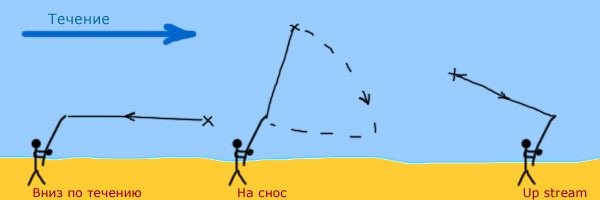
Often on a river you need a long cast. Here it is worth using turntables with a weighted core. For example: Mepps Heavy Long. In addition, the current often tends to push the spinner towards the surface. Weighted spoons are more difficult to push out, and therefore can be pulled deeper. This is often a plus, allowing you to get a bite from fish below the surface layer.
Share with your friends:
Category: Tackle Equipment
Tags: Spinner, Spinner, Mepps, River, Technique, Current
Selection by fishing season
Let's decide on the time of year, everything depends on this:
- Summer. Depends on temperature. In hot and sunny weather, the fish becomes passive and it is somewhat more difficult to provoke a bite. Use something smaller and lighter, such as spinners. In hot weather, passive fish do not chase “thick” and “well-fed” bait (large, heavy fish). It's much easier to catch a stupid little thing. Wiring should be slow and inactive. The length of the pinwheel is 3-7-10, not a bright color. In cloudy weather, experiment.
- Autumn. Active eating and “fat gain” begins. Use large, heavy shakers, 10-13 in length. They show up perfectly. You shouldn’t get hung up on a specific model; have in your arsenal rotators and vibrators of different weights and colors. It is enough to make 5-6 casts into the area where the fish may be, then act according to the circumstances.
- Winter. In winter, fishing is possible either on girders, or vertically on vertical or horizontal lines. They are not large in size: up to 8 cm, weighing 5-30 g. Depends on the specific fishing location. During currents, a heavy version is suitable; in still water, feel free to use a weight of 5 grams or more. It is worth noting that in cold, long frosts the fish rarely bite. There is less air under the ice and the pike becomes passive.
- Spring. Bring everything to the pond. For the top catchiest wobblers for predators, see the special article. Rotating spoons are a priority. Start your search for a predator with this type. It’s difficult to say what the fish wants on a particular day; you are looking for a bait that works today.
Wobblers that catch 100%:
Shimano FX
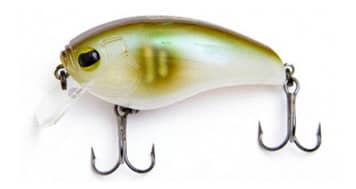
More details
Shimano FX

More details
Shimano FX
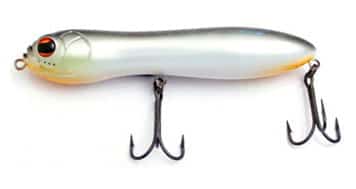
More details
Shimano FX
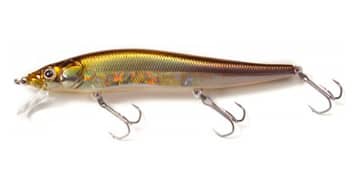
More details
We have discussed how to catch it depending on the season. Let's move on to the criteria for choosing gear:
- Fishing place. It doesn’t matter where you fish: a river or a lake. Conditions matter. Clean, flat surface of water or an area with grass where there is a high chance of getting hooked. In hard-to-reach places, use non-snappy gear, inexpensive gear, or something made by yourself. The latter have a low cost and are not scary to lose. The catch in such places is extremely high; pike are found in snags and grassy places.
- Average fishing depth. On a small river, fishing is carried out in shallow waters. On a large river (with or without current), you should choose heavy ones.
- Shore or boat. The factor is unimportant; it is easier to throw light weights from a boat. From the shore, on a large body of water, in windy weather, feel free to use heavier tackle.
- Weather. Important point. Anglers know that it bites differently depending on the fish. When it’s cloudy, use brighter and more colorful gear. In bright sunny conditions: natural, not too shiny. Excessive brightness can alert the fish.
Fishing technique with oscillating spoons
Oscillators or oscillating options are the most ancient gear. You don’t need to have any special equipment, the only wiring that comes with experience. The tackle has tangible, irrefutable advantages:
- In large currents, at sufficient depth (a couple of meters), use baits of a larger size and weight. Light tackle will be carried away by the current and will not sink to the horizon with the predator. You can experiment with the size, use weight from 20 grams.
- When using spinners made by yourself, or cheap options or openly Chinese (in the worst sense of the word) production, we recommend installing good tees. Try to put high-quality and sharp hooks - the situation with realized bites may change.
- Try to work out the quality of the wiring. Success depends on the quality of the wiring; thanks to it, the tackle plays as intended by the manufacturer.
- Due to their versatility, they can be used at any time, on any body of water with different wind conditions. Non-hooking, noise options - attracting even more attention to pike.
- A beginner needs to start with uniform wiring. A significant plus of the gear is that not every spinner or wobbler can be driven evenly.
- For light, clear water (weather), use natural colors that do not repel predators. In muddy water (it's been raining, it's spring) or cloudy, put shiny or bright tackle.
Spinners
There is no universal spinner (of any type). They work in their own conditions. At some time, spinners perform better, catching the ubiquitous perch. Collect a whole collection, try to catch it when the opportunity arises. Select a favorite with frequent bites. Most fishermen often fish in one place; not everyone has the opportunity to travel around in search of an interesting river.
- Rotators are partly bait for advanced fishermen. Doesn't mean that beginners shouldn't use them. It's a matter of wiring. Honing your skills, the catch will not leave you. Various fish (perch, chub, pike perch) are caught on the turntables.
- Retrofitability. For example, a load is added and it becomes heavier. Petals are added and removed. This makes it possible to use 1 to replace 2-3 pieces at once. Having arrived at the reservoir and adding cargo, a long cast is made. From the bottom, adding weights and a petal, a trophy predator is lured from the bottom.
- They imitate small fish better and more correctly. Due to the rotating petal, predators are able to recognize the “unrest” created during wiring at a great distance.
- They are often cheaper than their hesitant counterparts. This is due to the fact that much less material is wasted due to the smaller mass. It’s easy to buy good spinners at a reasonable price.
